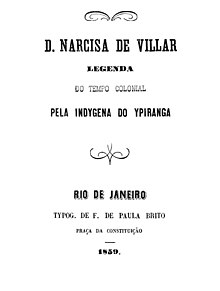D. Narcisa de Villar
 | |
| Author | Ana Luísa de Azevedo Castro |
|---|---|
| Language | Portuguese |
| Genre | Indianist romance |
| Published | 1859 |
| Publisher | Tipografia de Francisco de Paula Brito |
| Publication place | Brazil |
| ISBN | 9788586501210 (5th edition) |
| OCLC | 8106607279 |
| LC Class | PQ9697.A1 D6 |
D. Narcisa de Villar: Legenda do tempo colonial (Portuguese for 'Mrs. Narcisa de Villar: A Story of Colonial Times') is a novel by Ana Luísa de Azevedo Castro, first published as a book in 1859. Castro published it pseudonymously as Indígena do Ipiranga (Portuguese for 'Ipirangan Indigenous Person').[1] Before its release as a novel, the work was serialized in A marmota, a newspaper published in the state of Rio de Janeiro.[2]
The novel concerns the star-crossed romance between a Portuguese girl and Indigenous boy in colonial Brazil.[3] Matthews describes the work as Indianist;[4] Andreta and Alós note, similarly, that the work evinces a preference for the Indigenous peoples in Brazil over conquistadors.[5] De Alencar argues that it represents a precursor to modernism in Brazilian literature.[6] Wasserman compares it to the French novels Paul et Virginie (1788) and Atala (1801), as well as to the works of Brazilian writer José de Alencar such as O Guarani (1857)—although she notes that, unlike O Guarani, D. Narcisa de Villar does not "complicate moral matters" by describing Indigenous people in negative terms or Portuguese colonialists in positive terms.[3]
Notes
- ^ Mota, Isabela; Pamplona, Patricia (20 March 2020). Vestígios da Paisagem Carioca: 50 lugares desaparecidos do Rio de Janeiro (in Portuguese). Mauad Editora. p. 154. ISBN 978-85-304-0029-3.
- ^ Wasserman 2007, pp. 22–23.
- ^ a b Wasserman 2007, p. 23.
- ^ Matthews, Charlotte Hammond (2012). Gender, Race, and Patriotism in the Works of Nísia Floresta. Tamesis Books. p. 91. ISBN 978-1-85566-235-3.
- ^ Andreta & Alós 2014, p. 102.
- ^ de Alencar 2008, p. 65.
Sources
- de Alencar, João Nilson P. (2008). "Entre o fóssil e o fluido na literatura do século XIX: D. Narcisa de Villar". Olhares e Trilhas (in Portuguese). 9 (9): 63–71.
- Andreta, Bárbara Loureiro; Alós, Anselmo Peres (15 June 2014). "A representação feminina em D. Narcisa de Villar, de Ana Luísa de Azevedo Castro". Confluenze (in Portuguese). 6: 99–110. doi:10.6092/ISSN.2036-0967/4445.
- Wasserman, Renata Ruth Mautner (2007). Central at the Margin: Five Brazilian Women Writers. Lewisburg, Pennsylvania: Bucknell University Press. ISBN 978-0-8387-5872-4. OCLC 1148217438.
